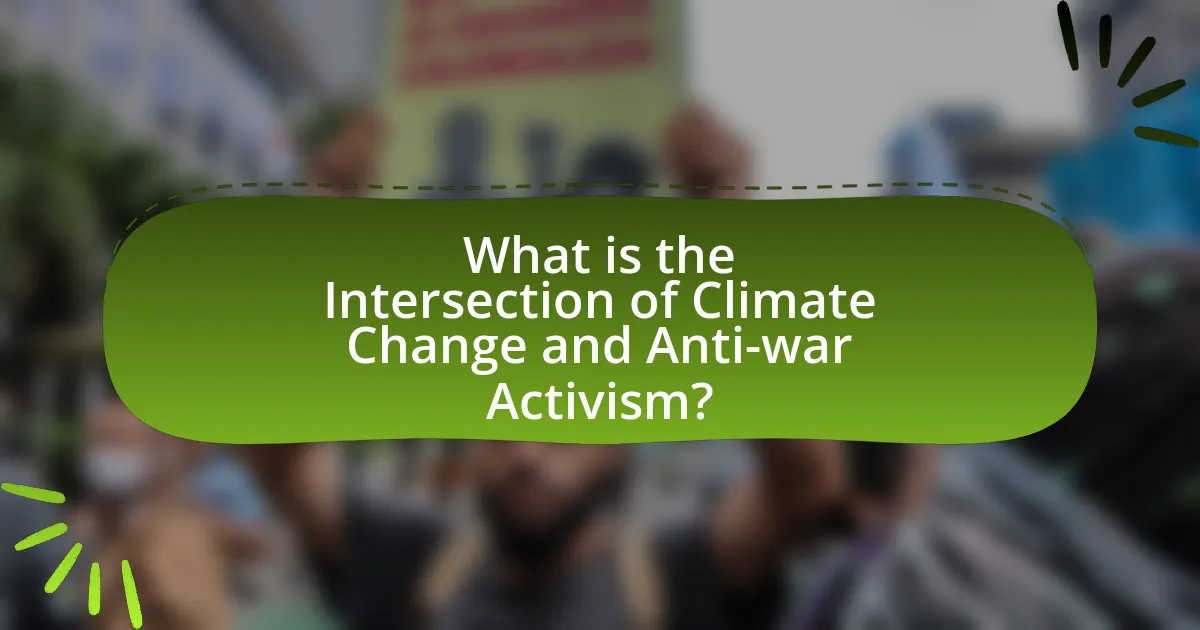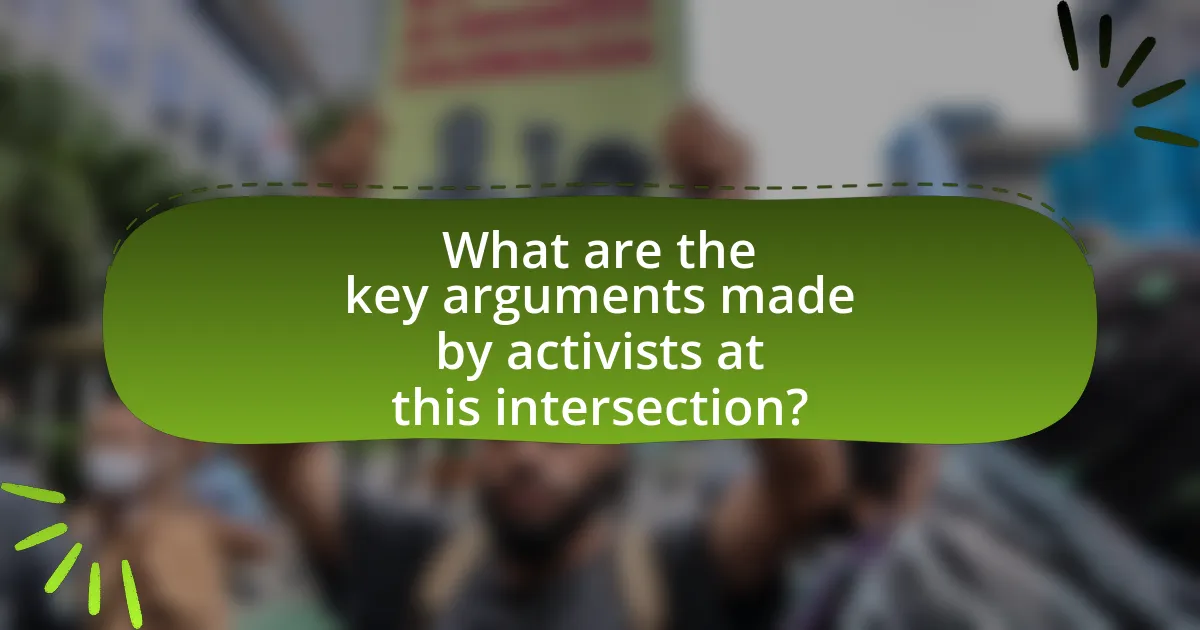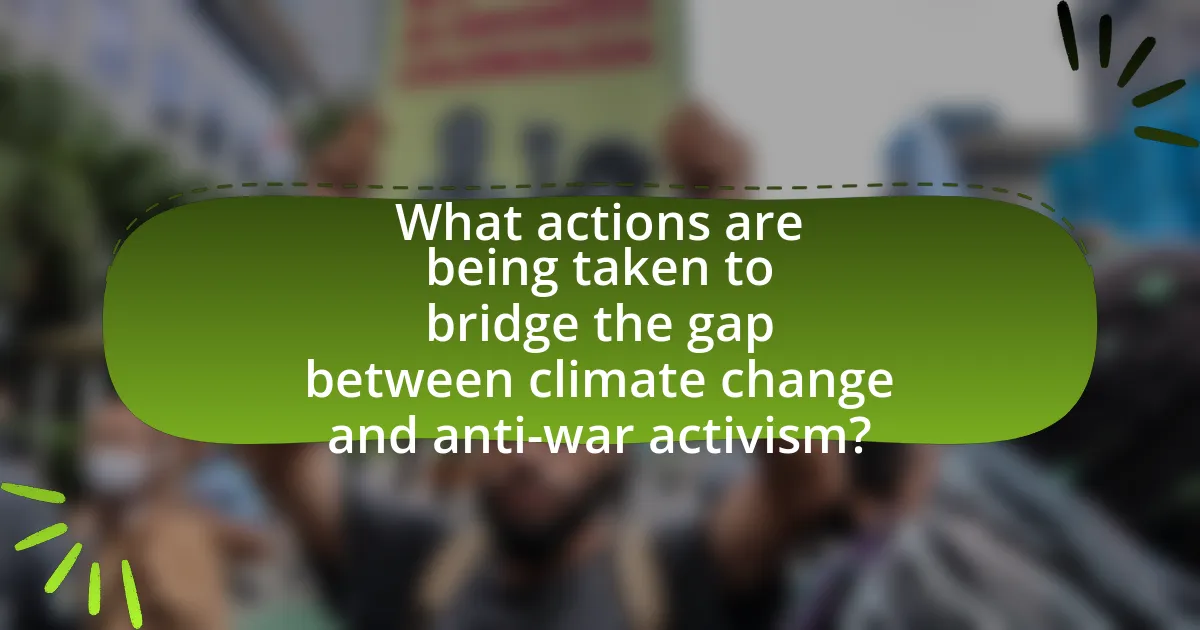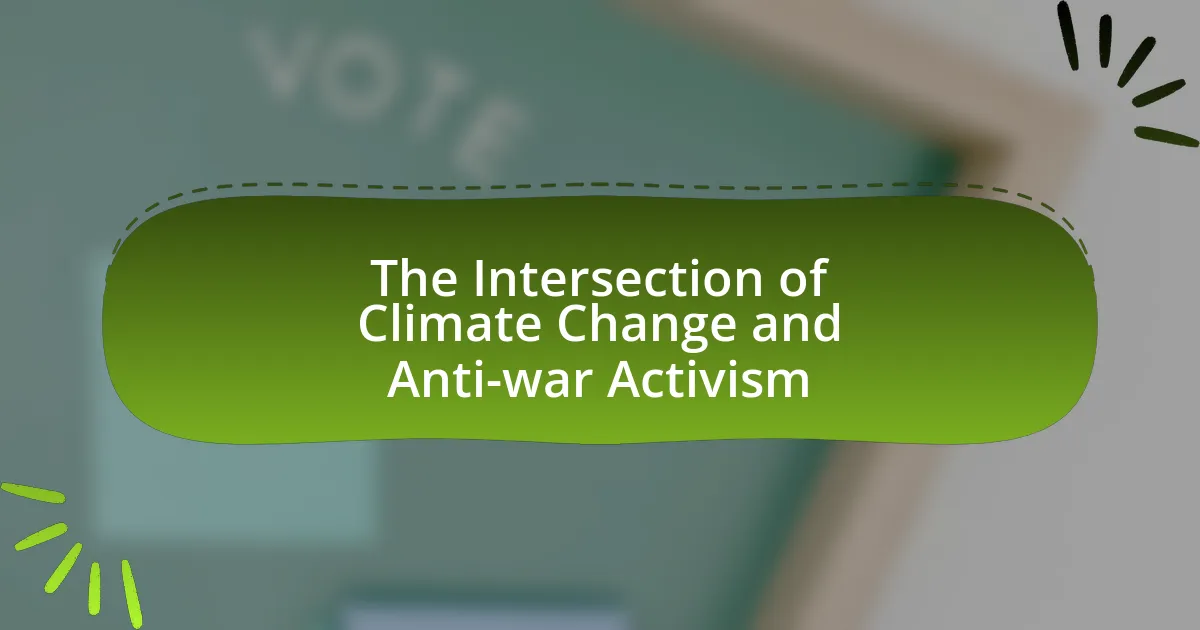The article examines the intersection of climate change and anti-war activism, highlighting how military activities contribute significantly to environmental degradation and greenhouse gas emissions. It discusses the U.S. Department of Defense as one of the largest institutional polluters and emphasizes the need for a holistic approach that integrates peacebuilding with climate action. Key historical events, activist perspectives, and the implications of ignoring this intersection are explored, along with potential strategies for collaboration between movements. The article underscores the urgency of addressing both climate change and militarism to foster sustainable peace and environmental justice.

What is the Intersection of Climate Change and Anti-war Activism?
The intersection of climate change and anti-war activism lies in the recognition that military activities significantly contribute to environmental degradation and climate change. Military operations are responsible for substantial greenhouse gas emissions, with the U.S. Department of Defense being one of the largest institutional polluters globally. For instance, a 2019 report by the Brown University Costs of War project estimated that the U.S. military’s carbon footprint is equivalent to that of entire countries, highlighting the environmental impact of war. Anti-war activists argue that reducing military spending and promoting peace can lead to more resources being allocated towards sustainable environmental practices, thereby addressing both climate change and the consequences of conflict.
How do climate change and anti-war activism relate to each other?
Climate change and anti-war activism are interconnected as both movements address the consequences of militarization on environmental degradation. Military activities contribute significantly to greenhouse gas emissions, with the U.S. Department of Defense being one of the largest institutional emitters globally. Furthermore, conflicts often exacerbate climate-related issues, leading to resource scarcity, displacement, and increased vulnerability to climate impacts. This relationship highlights the need for a holistic approach to both climate action and peacebuilding, as addressing one can positively influence the other.
What historical events have linked climate change and anti-war movements?
Historical events linking climate change and anti-war movements include the 2003 invasion of Iraq, where activists highlighted the environmental destruction caused by warfare, and the 2014 People’s Climate March, which saw anti-war groups participating to emphasize the connection between militarism and climate degradation. The Iraq War resulted in significant oil spills and destruction of ecosystems, prompting protests that framed military actions as exacerbating climate issues. Additionally, the 2019 Global Climate Strike incorporated anti-war messages, underscoring the belief that military spending diverts resources from addressing climate change. These events illustrate the growing recognition among activists that militarism and environmental degradation are interconnected.
How do activists perceive the impact of war on climate change?
Activists perceive the impact of war on climate change as significantly detrimental, arguing that military conflicts exacerbate environmental degradation and contribute to climate instability. They highlight that wars lead to increased greenhouse gas emissions through military operations, destruction of infrastructure, and displacement of populations, which in turn heightens vulnerability to climate-related disasters. For instance, a report by the International Institute for Sustainable Development indicates that military activities are responsible for approximately 5% of global carbon emissions, underscoring the substantial environmental footprint of armed conflicts. Activists also emphasize that the resources diverted to warfare could be better utilized for climate mitigation and adaptation efforts, further illustrating the interconnectedness of war and climate issues.
Why is the intersection of these two movements significant?
The intersection of climate change and anti-war activism is significant because both movements address the urgent need for systemic change to protect human life and the planet. Climate change exacerbates resource scarcity, leading to conflicts and wars, while militarization contributes to environmental degradation. For instance, the U.S. military is one of the largest consumers of fossil fuels, highlighting the direct link between military actions and climate impact. This intersection emphasizes the necessity for a holistic approach that integrates environmental sustainability with peace-building efforts, as seen in initiatives like the Green New Deal, which advocates for both ecological and social justice.
What are the potential consequences of ignoring this intersection?
Ignoring the intersection of climate change and anti-war activism can lead to exacerbated environmental degradation and increased conflict. The failure to address how militarization contributes to climate change results in a cycle where resource scarcity, driven by environmental factors, fuels further violence and instability. For instance, the Uppsala Conflict Data Program indicates that climate-related disasters can increase the likelihood of conflict by up to 50%. Additionally, neglecting this intersection undermines efforts to create sustainable peace, as military activities are significant contributors to greenhouse gas emissions, accounting for approximately 5% of global emissions according to the Stockholm International Peace Research Institute. Thus, ignoring this intersection not only hinders climate action but also perpetuates a cycle of violence and environmental harm.
How can understanding this intersection influence public policy?
Understanding the intersection of climate change and anti-war activism can significantly influence public policy by promoting sustainable practices that prioritize peace and environmental protection. Policymakers can integrate climate resilience into conflict prevention strategies, recognizing that resource scarcity often exacerbates tensions. For instance, the United Nations Environment Programme has reported that climate change can lead to increased competition for resources, which may trigger conflicts. By addressing these issues, public policy can foster cooperation and peacebuilding initiatives that also mitigate climate impacts, ultimately leading to more holistic and effective governance.

What are the key arguments made by activists at this intersection?
Activists at the intersection of climate change and anti-war activism argue that militarism significantly contributes to environmental degradation and climate change. They highlight that military operations are major sources of greenhouse gas emissions, with the U.S. Department of Defense being one of the largest institutional polluters globally. Additionally, activists assert that war exacerbates climate vulnerabilities, displacing populations and hindering sustainable development efforts. They advocate for a shift in resources from military spending to climate action, emphasizing that addressing climate change requires peace and stability, as conflict disrupts environmental initiatives and exacerbates resource scarcity.
What are the main concerns of anti-war activists regarding climate change?
Anti-war activists primarily express concerns that military actions exacerbate climate change and divert resources from addressing environmental issues. They argue that armed conflicts contribute significantly to greenhouse gas emissions, with military operations and weapons production being major polluters. For instance, a 2019 study by the Stockholm International Peace Research Institute highlighted that global military emissions are comparable to those of entire countries, underscoring the environmental impact of defense spending. Additionally, anti-war activists emphasize that the militarization of responses to climate-related disasters can lead to further violence and instability, hindering effective climate action and exacerbating humanitarian crises.
How does militarization contribute to environmental degradation?
Militarization contributes to environmental degradation primarily through the destruction of ecosystems and pollution caused by military activities. Military operations often involve the use of heavy machinery, explosives, and chemicals, which can lead to habitat destruction, soil degradation, and water contamination. For instance, the U.S. Department of Defense is one of the largest polluters in the world, with military bases and training exercises resulting in significant environmental damage, including the release of hazardous substances into the environment. Additionally, military conflicts can lead to deforestation and loss of biodiversity, as seen in war-torn regions where natural resources are exploited for war efforts. These activities not only harm local ecosystems but also contribute to broader climate change issues by increasing greenhouse gas emissions.
What role does resource exploitation play in conflicts related to climate change?
Resource exploitation significantly exacerbates conflicts related to climate change by intensifying competition for dwindling natural resources. As climate change leads to resource scarcity, such as water and arable land, communities and nations increasingly vie for control over these essential assets. For instance, the 2011 conflict in Syria has been partially attributed to prolonged droughts that devastated agriculture, prompting migration and social unrest, which were further fueled by competition over water resources. This illustrates how resource exploitation, driven by climate change impacts, can ignite tensions and lead to violent conflicts.
How do climate change advocates view war and militarization?
Climate change advocates generally view war and militarization as significant contributors to environmental degradation and climate change. They argue that military activities consume vast amounts of resources, emit greenhouse gases, and disrupt ecosystems. For instance, the U.S. military is one of the largest institutional consumers of fossil fuels, with estimates indicating it emits more carbon dioxide than many countries. Additionally, conflicts often lead to deforestation, pollution, and displacement of communities, exacerbating climate vulnerabilities. Thus, climate change advocates emphasize the need for peace and disarmament as essential components of effective climate action.
What evidence supports the claim that war exacerbates climate issues?
War significantly exacerbates climate issues through environmental destruction, increased greenhouse gas emissions, and resource depletion. For instance, the U.S. invasion of Iraq in 2003 resulted in the burning of oil wells, releasing millions of tons of carbon dioxide into the atmosphere. Additionally, military activities contribute to deforestation and habitat destruction, as seen in conflicts in the Amazon and Southeast Asia, where armed groups exploit natural resources. A study by the International Institute for Sustainable Development highlights that military operations are responsible for approximately 6% of global greenhouse gas emissions, underscoring the direct link between warfare and climate change. Furthermore, the aftermath of war often leads to weakened governance, hindering effective environmental policies and exacerbating climate vulnerabilities in affected regions.
How do climate activists propose to address the military’s carbon footprint?
Climate activists propose to address the military’s carbon footprint by advocating for a reduction in military spending and a transition to renewable energy sources. They argue that the military is one of the largest institutional consumers of fossil fuels, contributing significantly to greenhouse gas emissions. For instance, a report by the Costs of War project at Brown University indicates that the U.S. military’s operations and infrastructure account for approximately 80% of the federal government’s energy consumption. Activists suggest reallocating military budgets towards sustainable technologies and emphasizing demilitarization as a strategy to combat climate change effectively.

What actions are being taken to bridge the gap between climate change and anti-war activism?
Actions being taken to bridge the gap between climate change and anti-war activism include collaborative campaigns that highlight the links between militarism and environmental degradation. Organizations such as the Climate and Militarism Project advocate for reducing military spending to redirect funds toward climate solutions, emphasizing that military operations contribute significantly to greenhouse gas emissions. Research indicates that the U.S. military is one of the largest institutional emitters of carbon dioxide, which reinforces the argument for integrating anti-war efforts with climate action. Additionally, activists are organizing joint protests and educational events to raise awareness about how war exacerbates climate crises, thereby fostering a unified movement that addresses both issues simultaneously.
What initiatives exist that combine climate action with anti-war efforts?
Initiatives that combine climate action with anti-war efforts include the “Green New Deal” and organizations like “World Beyond War.” The Green New Deal advocates for a transition to renewable energy while addressing economic inequality, linking climate justice with peace by promoting disarmament and reducing military spending. World Beyond War focuses on educating the public about the connections between militarism and environmental degradation, emphasizing that military activities contribute significantly to carbon emissions. These initiatives highlight the interdependence of climate stability and global peace, aiming to create a sustainable future free from the impacts of war.
How are grassroots movements addressing both climate change and militarism?
Grassroots movements are addressing both climate change and militarism by advocating for policies that prioritize environmental sustainability while opposing military expenditures that contribute to ecological degradation. These movements, such as the Sunrise Movement and Veterans for Peace, emphasize the connection between military activities and environmental harm, highlighting that military operations are significant contributors to greenhouse gas emissions. For instance, the U.S. Department of Defense is one of the largest institutional consumers of fossil fuels, which exacerbates climate change. By organizing protests, lobbying for legislative changes, and raising public awareness, grassroots movements aim to shift funding from military budgets to renewable energy initiatives, thereby promoting a dual agenda of peace and environmental justice.
What role do international organizations play in this intersection?
International organizations play a crucial role in the intersection of climate change and anti-war activism by facilitating dialogue, promoting sustainable development, and advocating for peace. These organizations, such as the United Nations and the World Bank, create platforms for countries to collaborate on climate initiatives while addressing the impacts of conflict on environmental degradation. For instance, the UN’s Sustainable Development Goals explicitly link peace, justice, and strong institutions with climate action, emphasizing that sustainable peace is essential for effective climate responses. Additionally, international organizations often provide funding and resources for projects that aim to mitigate climate change in conflict-affected areas, thereby addressing both environmental and humanitarian needs simultaneously.
How can individuals contribute to this intersection of movements?
Individuals can contribute to the intersection of climate change and anti-war activism by advocating for policies that address both issues simultaneously. For instance, they can support legislation that promotes renewable energy while also reducing military expenditures, as military operations significantly contribute to carbon emissions. According to a study by the Costs of War project at Brown University, the U.S. military is one of the largest consumers of fossil fuels, highlighting the need for a shift in priorities. By participating in grassroots movements, raising awareness through social media, and engaging in community discussions, individuals can amplify the message that climate justice and peace are interconnected, fostering a more sustainable and peaceful future.
What practical steps can activists take to promote awareness of this issue?
Activists can promote awareness of the intersection of climate change and anti-war activism by organizing educational campaigns that highlight the environmental impacts of militarization. These campaigns can include workshops, public lectures, and social media outreach to inform communities about how military activities contribute to climate degradation, such as increased carbon emissions and resource depletion. For instance, a report by the Costs of War project at Brown University indicates that the U.S. military is one of the largest institutional consumers of fossil fuels, which underscores the urgency of addressing this issue. Additionally, activists can collaborate with environmental organizations to create joint initiatives that emphasize the shared goals of peace and sustainability, thereby broadening their reach and impact.
How can community engagement enhance the effectiveness of these movements?
Community engagement enhances the effectiveness of climate change and anti-war movements by fostering collective action and amplifying diverse voices. When communities actively participate, they create a sense of ownership and responsibility towards the issues, leading to increased mobilization and advocacy efforts. Research indicates that grassroots movements, which rely on community involvement, are more successful in influencing policy changes and raising awareness. For instance, the 2019 Global Climate Strike, driven by community-led initiatives, mobilized millions worldwide, demonstrating the power of collective engagement in addressing both climate and peace issues.
What are the future implications of the intersection of climate change and anti-war activism?
The future implications of the intersection of climate change and anti-war activism include a potential shift in global priorities towards sustainability and peace, as both movements advocate for the protection of human life and the environment. As climate change exacerbates resource scarcity and displacement, anti-war activists may increasingly emphasize the need for peaceful resolutions to conflicts that arise from these pressures. Historical evidence shows that environmental degradation can lead to social unrest; for instance, the Syrian civil war has been partially attributed to severe drought conditions linked to climate change. This intersection may foster collaboration between activists, leading to unified efforts that address both environmental and social justice issues, ultimately influencing policy changes that prioritize ecological sustainability and conflict resolution.
How might global conflicts evolve in the context of climate change?
Global conflicts may evolve in the context of climate change through increased competition for dwindling resources, such as water and arable land. As climate change leads to extreme weather events and rising sea levels, regions may experience food and water shortages, prompting tensions between nations and communities. For instance, the 2011 Syrian civil war has been partially attributed to a severe drought exacerbated by climate change, which displaced rural populations and contributed to social unrest. Additionally, the Intergovernmental Panel on Climate Change (IPCC) warns that climate-related impacts could exacerbate existing geopolitical tensions, leading to conflicts over migration and territorial disputes.
What strategies can be employed to foster collaboration between these movements?
To foster collaboration between climate change movements and anti-war activism, establishing common goals and shared narratives is essential. By identifying overlapping interests, such as the impact of militarization on environmental degradation, both movements can create a unified front. For instance, studies have shown that military activities contribute significantly to carbon emissions, which can serve as a focal point for joint campaigns. Additionally, organizing joint events, such as protests or educational forums, can enhance visibility and solidarity, allowing participants to share resources and strategies effectively. Collaborative partnerships with NGOs that focus on both issues can also amplify their voices and broaden their reach, as evidenced by successful coalitions formed in various regions that address both climate justice and peace initiatives.



